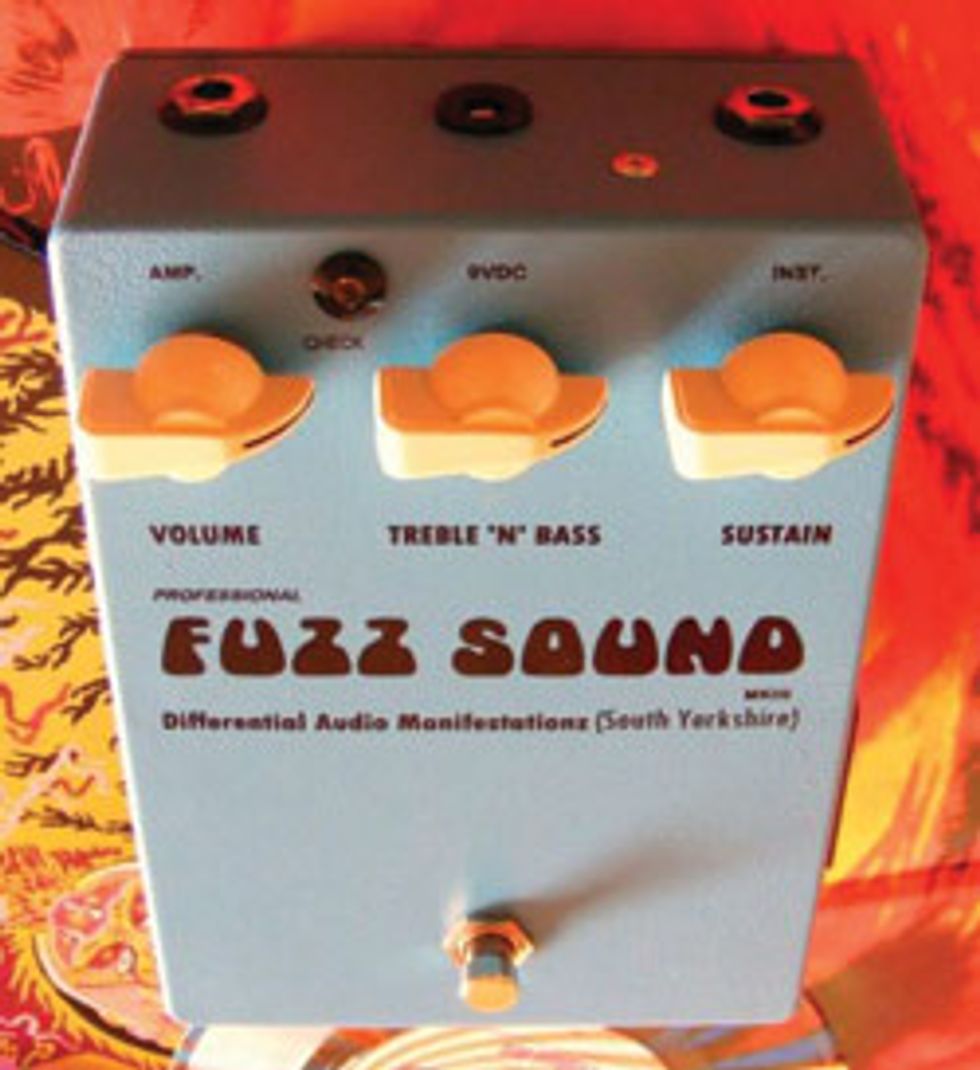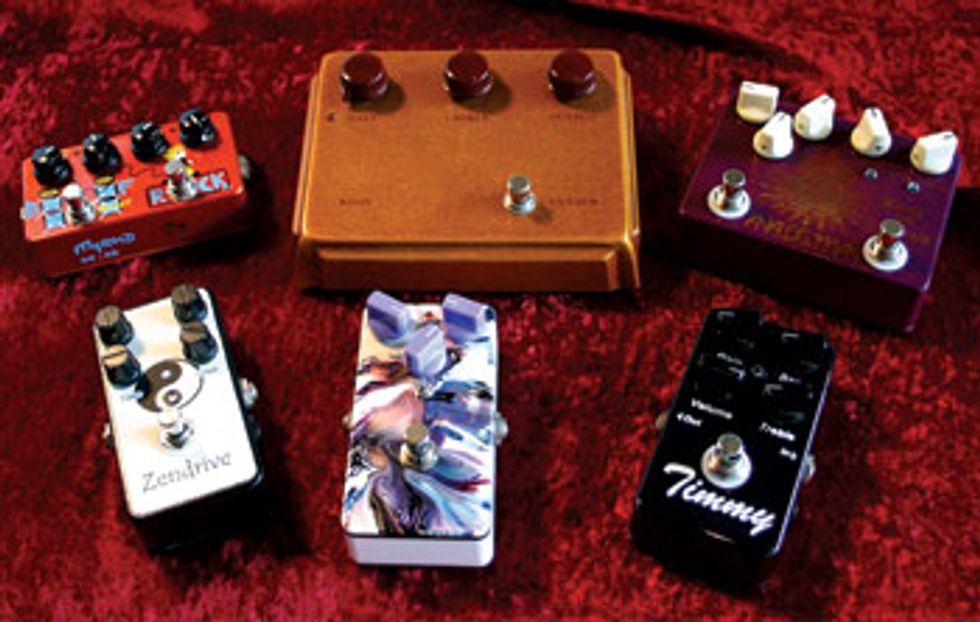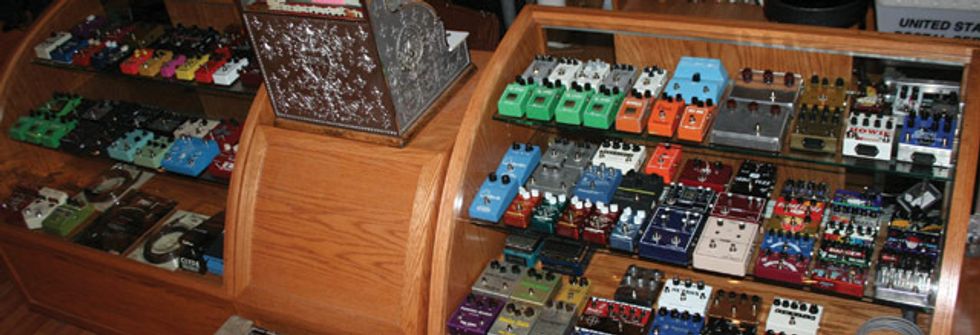It’s been nearly five years since I wrote Analog Man’s Guide To Vintage Effects. The book has sold remarkably well for a self-published tome with no distribution written for a specific, niche audience on such an obscure topic.
There was a chapter in the book titled “State of the Stomp Today,” where I summarized the stompbox scene as it then existed. Well, a lot can happen in five years, so when the folks at Premier Guitar asked me to write a feature for their pedal issue, it seemed like a great opportunity to look at some of what’s happened since that time.
One thing I noted in Analog Man’s Guide was the then striking proliferation of new up-and-coming pedal makers. Between 2001 and 2004 they seemed to have come out of the woodwork. Little did I know it was just the first trickle of the flood to come. The boutique pedal market of today far exceeds anything that existed five years ago. Oversaturation does not even begin to describe it. It’s been estimated that there are (ready for this?) more than 2,000 different pedal “brands” currently available on the market. It’s absolutely staggering! This figure, of course, includes everything from the biggest, most well-known brands, such as Boss or Electro-Harmonix, to the smallest little one-man startups selling homemade Fuzz Face clones with Sharpie graphics on eBay. Not surprisingly, the majority of brands accounted for here are somewhere closer to the latter category. I used to try and keep track of it all, but I’ve long since given up. Suffice it to say, there’s a lot to choose from in today’s pedal market.
Let’s Talk about What’s HOT!
Fuzz
 D*A*M Fuzz Sound. |
YouTube
The latest online phenomenon (aside from social networking) is that behemoth streaming video entity known as YouTube. Videos good and bad alike can be found demonstrating all types of musical gear, and people just can’t seem to get enough of it. It’s interesting to see (via the YouTube hit counter) just how many people will watch someone’s crappy cell phone video on that little viewer with the super compressed audio. But if it’s a demo of that cool new pedal you’re gassing for, you somehow find yourself watching it, and watching it again, and again … and again. Fortunately, there have been some good video demos made, and more are being uploaded every day. Yep, you can pretty much find anything on YouTube.
Not Quite as Hot, But Still Smoldering
Expensive Boutique Overdrives
Although still very popular, the boutique overdrive market reached its zenith sometime in 2007, and has since throttled back from sheer insanity to healthy enthusiasm. The Clay Jones Overdrive (only 52 made), Landgraff Dynamic Overdrive, and Klon Centaur with the Gold Horseyman were among the most expensive at anywhere from $500 to over $1,000 used. The Zen Drive, Tim/Timmy, and King of Tone were de rigueur among The Gear Page set, consistently fetching more on the used market than they were new. But the recession seems to have tempered that “I gotta have that now” mentality, and used prices have stabilized and become more reasonable.
Not Even Close
Rackmount Multi-Effects
We hate to disappoint anyone, but these have yet to make a comeback. This may come as a shock to a few headbanging hairmetal shredmeisters, but it’s true. Hey, don’t kill the messenger, I’m just telling it like it is. Maybe in a few years things will be different. I mean, who would have guessed that Fenders and Gibsons from the ’70s would actually become collectible?
Today’s Typical Pedal User
One of the most striking things about the average modern guitarist is the amount of attention and importance he places on his gear. Choices about every facet of a player’s rig are considered, from instrument to amp and everything in between. Nothing is overlooked, including cables and other accessories that players didn’t think twice about 20 or 30 years ago. To a large extent, this was already happening at the time the book was published, but in the intervening years since, it seems almost as if many players have put their tone under a microscope.
To a large extent, the average guitarist now owns a whole lot more gear than in earlier decades. Items that were once deemed luxuries are now indispensible. In addition to owning several different types of guitar pedals, it’s a fairly common practice to own two or more of the same type of pedal, particularly when it comes to dirt boxes. It’s not enough to get a crunchy or distorted soundor more sustain for singing leads. We need one overdrive for a chunky rhythm, an “amplike” mild OD, buffered clean boost, a nice smooth distortion, an old school germanium fuzz, another fuzz that’s a little more wild … and that’s just for our 30-watt/single-coil rig. We need a whole other set of pedals for our 50-watt/humbucker rig.
The Internet continues to play a large role in influencing and informing the choices and decisions of today’s guitarist. We live in an age of information overload, where information about any topic imaginable can be found literally at the tips of our fingers (whether or not that info is accurate is another story). Gear-centric Internet forums and bulletin boards are even more popular and diverse then ever. Harmony Central and The Gear Page continue to top the list of busiest bulletin boards, with Harmony Central boasting an astonishing 200,000+ membership, and almost 52,000 members at The Gear Page. That’s a lot of gear talk!
There are plenty more active gear forums out there, with memberships ranging from a few hundred to several thousand. So you can just imagine the enormity of useful and interesting info being exchanged among members. There’s also a lot of bunk and off-topic nonsense, and you may have to weed through a lot of it to get to what you’re looking for. And unfortunately, there’s plenty of erroneous information as well, along with no shortage of misinformed individuals all too willing to share their opinions with anyone they think is listening. But hey, that’s the internet. With a little common sense, and a healthy skepticism for hype, reliable info is available to anyone who’s willing to put in a little footwork.
 From my personal stash: Z.Vex Box of Rock, Klon Centaur, custom Analog Man King of Tone, Hermida Zendrive, Landgraff Dynamic Overdrive, Paul Cochrane Timmy. |
In preparation for this piece, I posted some questions on a few of the online guitar forums that I frequent, asking the forumites (as the registered members are known) various questions to help describe the current stompbox scene. There were a lot of great replies and a number of astute observations from players who are immersed in the pedal world. The commentary quickly revealed a couple of recurring themes that demonstrate a paradox of sorts. First, there was praise for the variety and quality of today’s offerings, as well as the abundance and availability of information about the products. At the same time, there was a sense that this has perhaps resulted in having too much of a good thing. The statements below are a reflection of the first sentiment:
“I honestly think it’s better than ever right now. You have a ton of variety to choose from, high quality builds, innovative new stuff, etc. More info at your fingertips than ever before to make informed buying decisions, and the forum system to connect directly with manufacturers. This is the golden age people, seriously.”
“I agree. When I was first playing guitar, I mostly remember just seeing Boss, Digitech and Ibanez pedals at the stores. But now, with so many people offering pedal mods to popular big brand pedals (Boss, Ibanez...), and so many small companies putting out high quality pedals, which often are better quality at a comparable price to the big companies, some of the larger companies are taking note. You see Danelectro finally offering metal housing again instead of plastic, and true bypass... and Digitech releasing their Hardwire line...
“I think one of the best helps for the pedal scene has, of course, been the Internet—with forums like this, and demos being released by everybody on YouTube, we can find out about the amazing pedals being made (or modded) by these independent guys, which we wouldn’t have found out about if we were just looking at our local stores. Sure, there is a lot of the same ... but at least there are options like Barber and the Timmy, etc. as opposed to just TS and Boss overdrives! I really like the options out there right now.”
“More and more top-quality ‘boutique’ hand-built pedals are coming into the $150 range. Builders are way more up-front about the lineages of their circuits and what you can expect them to do. Samples and reviews and discussions from the average Joe are more available everyday. This is all a huge ‘win-win’ for the GASSY masses such as us. THE INTERNET ROCKS.”
The majority of replies, however, conveyed an overwhelming feeling that the pedal market of today is immensely oversaturated, especially with regards to the smaller, part-time builder brands. A lot of the respondents were brief and to the point: “Overcrowded,” “Too many choices,” “Lotsa the same stuff in different packages,” “Enough of the same OD,” and “Here’s the new box, the same as the old box” were just some of the statements made to this effect.
Coupled with this was the prevailing attitude that the bulk of new makers were offering products that were essentially the same as what was already abundantly available, the biggest offender being the “boutique” Tube Screamer clone, and dirt pedals in general. The following are typical examples of this vein of criticism:
“I think that in the last 2 or 3 years there has been an explosion of companies offering a lot of the same product.”
“It would be nice if there was a little more diversity in the offerings. Seems like almost every site I go to has the same basic kit (higain/ low-gain fuzz, OD, line buffer, distortion). Of course, that is what sells, so that is a fair situation. I am just saying it would be nice to see more freaky stuff.”
“In the ‘60s, great players made wonderful music with just a few available effects. Now, hobbyists and part-timers spend thousands on a multitude of too-similar-to-compare pedals, often trying to sound like those players back then with their few primitive effects.” “These days it does feel less like the cream rising to the top and a bit more like panning for gold.”
There were many other interesting observations as well, interspersed within these main themes. Here are some random examples that stood out, which help illustrate the sort of highly engaging conversations taking place in the forums:
“Customers have set a new bar for what somebody will pay for a brand new pedal with the last few D*A*M eBay auctions topping out at over $1400 and the going rate of Cornish pedals. People will drop serious cash for fuzz.”
“I think the ‘builder’ has taken a much too prominent place in the market (compared to) the actual products. Sometimes it seems like people are more loyal to the builders than the products they put out.”
“I think the two sides are merging: mass producers are starting to add more boutique features (Danelectro, etc), and people are using more and more pedals on their boards nowadays (because now you can actually buy a board instead of having to make one).
“Since 2000 there has been an exponential rise in manufacturers and diversity of designs. While many builders are focusing on clones of vintage pedals exclusively, there are many more that are pushing the boundaries of effects design. There still remains the issue of the boutique vs. generic consumer. Forum readers always believe that they are the center of the effects world and everyone knows about their discussions. However, boards belonging to professional musicians overwhelmingly show that the readily available and mass produced effects are still the primary focus of major working musicians. As in years past, this continues to shed light on the relatively small scope of Internet discussion boards in the grand scheme of guitar playing.”
“You can get the most pimp, top of the line, status symbol pedal for 300-500 bucks. 300-500 bucks will get you nothing good as far as guitars and amps go. This is the economy at work. People gotta be spending their money on something, so now pedals are extremely hot.”
“Beggars are choosers. You show someone an $80 Boss pedal and ‘Whoa this is crap. I’m too good for this.’ But you show the same person a $250 pedal and they’re like ‘Whoa, this is too expensive.’ People wanna have their cake, eat it, AND get a refund.”
Okay, I have to admit, that last comment was one of my favorites. But there were many such observations and dialogs. And though only a small sampling, the commentary above represents the typical exchange of ideas among the gear heads on the frontline of today’s thriving, ever-evolving stomp scene. There’s never any shortage of great gear conversation, that’s for sure.
Well, here we are, just about out of time and space and I feel like I’ve barely scratched the surface. This is only a snapshot through the Hubble scope of the continually expanding, seemingly limitless universe of the stompbox. I’m continually amazed at how passionate some of us can be about all of this. We gear geeks are certainly a special breed. I hope you’ve enjoyed this little pedal excursion as much as I have. Here’s to good tone; to each his own. Until we meet again, do keep on stompin’!










![Rig Rundown: Russian Circles’ Mike Sullivan [2025]](https://www.premierguitar.com/media-library/youtube.jpg?id=62303631&width=1245&height=700&quality=70&coordinates=0%2C0%2C0%2C0)










